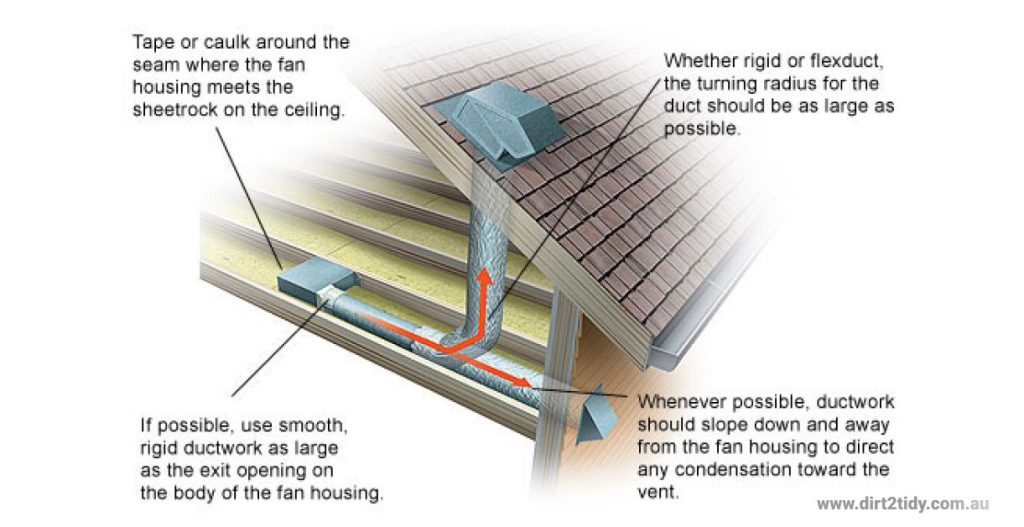Table of Contents
Introduction:
Bathroom vent systems are essential for controlling moisture and preventing mold. Typically, a bathroom exhaust fan is mounted on the ceiling to draw damp air out and push it through the roof or an attic opening. However, many homes have a hidden issue while you may see vents for dryers and furnaces, there’s often no dedicated vent for bathroom fans. This lack of proper ventilation can cause moisture buildup, damage to structures, and poor indoor air quality.
What Happens to Bathroom Vents?
Connecting the bathroom ventilation fan directly to an existing stack is one option. You’ll need a vent cover for that, and your exhaust fan may need to be properly fitted as well for proper ventilation. During end of lease cleaning, ensuring the bathroom is thoroughly cleaned and well-ventilated can help avoid moisture damage and meet inspection standards.
The second option is to install a bathroom exhaust fan elbow. The elbow will create a vent for the air from the bathroom exhaust fan, which will cut a hole and make installation simple.
If correctly placed, bathroom exhaust fans can ventilate out windows or doors in the residence.
Is It Necessary for A Bathroom Extractor Fan to Vent to The Outside?
Yes, the bathroom fan should be vented outdoors through an exhaust duct or something similar to remove mold and mildew.
A widespread myth is that a bathroom extractor fan may be used without being vented to the outside. Remember, your aim is to get damp air and odors out of the house as soon as possible. That implies draining via pipes in your house, away from apartment buildings, or away from a septic tank in rural locations with detached dwellings.
Regardless of whether you use your extractor fan for 10 minutes or 15 hours per day, it needs one way to get rid of moist air: through an existing vent opening in the upper part of an exterior wall, a ceiling or roof vent cap for fifth-wheel, or final vents on rafters, over the far side from the ridge cap.

Is It Necessary for A Bathroom Fan Exhaust to Vent Outside?
- Not always required: A bathroom exhaust fan doesn’t always need to vent outside, but doing so is recommended for proper moisture control.
- Alternative option: In some houses, especially with brick fronts, you can install an outlet immediately outside the house, connecting the fan through a roof-vented pipe.
- Check local codes: Always ensure the installation complies with your municipal code or building authority’s requirements.
- Proper support: Some standards require fans to be supported by their own weight rather than nailed or hammered into walls or ceilings.
- Safe placement: Keep the exhaust unit away from other mechanical systems like heating ducts or plumbing to avoid interference.
- Roof slope consideration: Steep roof designs in some areas may limit installation options, so planning is essential.
You may also like to read about- “Ultimate Guide to Cleaning Bathroom Grime in Furnished Rentals”
Why Following Manufacturer’s Installation Guidelines Matters
It’s crucial to pay close attention to the installation instructions provided by your fan’s manufacturer. These guidelines aren’t just suggestions they help ensure the fan operates as intended, keeps your bathroom free from excess moisture, and prolongs the unit’s lifespan.
Manufacturers outline key factors like the maximum length and number of bends (elbows) allowed in your ductwork. Ignoring these details can lead to weak airflow, causing moisture and odors to linger. Over time, this extra humidity invites mold, mildew, and even structural damage.
Stick to the recommended instructions whether they concern duct length, vent angles, or other specifics to guarantee your extractor fan works efficiently and keeps your bathroom healthy.
Because they might generate false alerts, smoke alarms should not be placed near ventilation equipment such as bathroom fans. To guarantee optimum operation, you should always check your smoke alarm once a month. When required, replace the batteries.
These sorts of connections are totally achievable as long as there is access to fresh air and may be extremely successful in adding a modest quantity of moisture removal to your house ventilation.
Bathroom fans should always be vented outside through an open window or fan into the attic to remove excess moisture. This is the safest technique to evacuate damp air from bathrooms since it avoids producing negative pressure on your home’s walls or ceilings, which might lead to mould growth.
If you want to run your bathroom fan for an extended period of time, make sure the exhaust is directed outdoors. If your house was built before around 80’s, there should already be a vent leading to open-air ventilation.
Some jurisdictions have construction standards that mandate bathroom fans to vent straight outside, while others do not.
If you’re considering installation options, Family Handyman explains how bathroom fan venting works
in detail.

Considerations for Cold Climates When Venting Through the Roof
Venting a bathroom fan through the roof is common, but colder climates introduce unique challenges. In regions with heavy snowfall think New Hampshire winters, for example snow accumulation can block roof vent openings entirely. When this happens, the moist air from your bathroom has nowhere to escape. As a result, condensation may build up inside the vent duct, leading to potential water damage, icing, or even mold growth inside your attic.
To address these issues, it’s wise to install a vent cap designed to prevent snow or ice clogging. Additionally, consider routing the vent to a gable end wall if your roof is prone to significant snow cover. Always check with your local building codes for climate-specific recommendations to ensure safe and effective ventilation.
Where Should I Vent My Bathroom Fan?
You should vent your fan so that there is at least 18 inches between the bathroom ceiling and any walls or windows, and 6 inches beyond any impediment beyond the top of the fan. Allow for a 1-inch space on either side of your fan as well.
How Far From a Roof Overhang Should You Place a Bathroom Fan Wall Vent?
When choosing a spot for the wall vent, aim to keep it a good distance away from any roof overhangs. As a general rule, position the vent at least 3 to 5 feet away from the edge of the overhang. This separation helps prevent moisture-laden air from getting trapped under the roof, which can cause wood to rot or lead to other ventilation issues down the road.
By giving yourself this buffer, you’re helping ensure proper airflow and reducing the chance of condensation problems near your roofline.
Why You Should Avoid Venting Near Soffit Vents
It’s tempting to choose the closest exterior wall or roof edge for your bathroom vent exit, but be wary of placing the exhaust outlet near a soffit vent. Here’s the snag: soffit vents are designed to draw in fresh air to ventilate your attic, not to welcome back the moist, warm air you’re trying to expel from your bathroom.
When you vent too close, that humid exhaust will inevitably get sucked right back up into the attic through those soffit openings. The result? You’re reintroducing moisture to the very space you want to keep dry, increasing the risk of mold and compromising your attic insulation. In the end, all your ventilation effort floats up and undoes itself, leaving you with the same problems you set out to solve.
The only thing you’ll need to do to follow the above guidelines is wrap tape around the vent pipes at regular intervals and then look for where it links with surfaces. Measure the lengths between taped spots (pipes) and write them down.
Make an X over any point that comes into contact with a surface that you wish to be 6 inches away from. This should give you a good sense of where your pipe should escape from within your drywall during installation.
You may also like to read about- “How do people design a bathroom to be easy to clean?”
How Many Bends and How Much Pipe Can I Use?
When planning your bathroom fan ductwork, it’s essential to stick to the manufacturer’s instructions regarding duct length and the number of bends (elbows). Most fan makers, such as Panasonic or Broan, typically recommend limiting a duct run to no more than two to three 90-degree elbows, and keeping the total length under 25 feet for optimal airflow. Keep in mind, each elbow reduces the effective length often, a 90-degree turn can count as 5 feet of straight run.
For the best results:
- Limit the number of elbows as much as possible too many can restrict airflow and lower the fan’s effectiveness.
- Add up the total length of your ducting, including adjustments for each bend, and make sure it doesn’t exceed the manufacturer’s maximum.
- Always use smooth, rigid ductwork where practical, as flexible ducting increases resistance.
If your duct configuration risks exceeding these limits, you may need a more powerful fan or a different route. Double-check the installation guide that comes with your fan for the specific numbers, as they can vary slightly from one model to another.
Careful planning here will ensure your bathroom stays dry, ventilated, and mold-free no shortcuts!
Conclution:
Although some homes may have alternative setups, the best practice is always to ensure your bathroom vent exhausts outside. Venting moisture-laden air indoors can lead to mold growth, unpleasant odors, and long-term structural issues. By following local building codes and ensuring proper installation, you protect your property and improve indoor air quality. For a thorough cleaning and maintenance service that complements proper ventilation, Dirt2Tidy can help keep your bathrooms fresh, hygienic, and damage-free.
Ensure a spotless bathroom before moving out – book your end of lease cleaning quote now !





